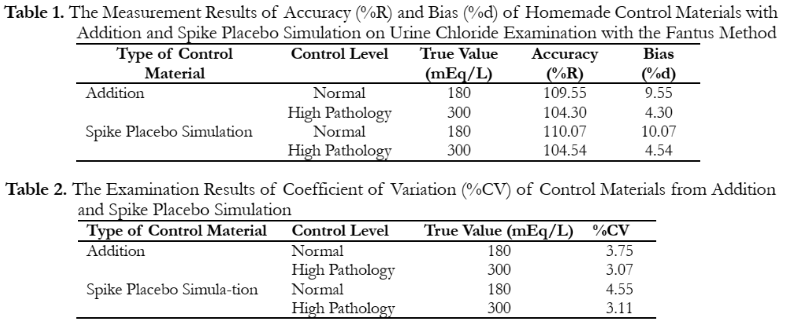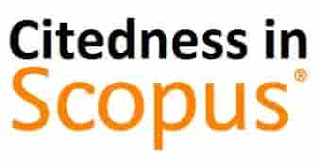Performance Test of Homemade Control Materials from Addition and Spike Placebo Simulation on Urine Chloride Examination with Fantus Method
Abstract
The background of this research was to examine the performance of homemade urine control materials on urine chloride examination. This study was aimed to test the performance of homemade control materials from addition and spike placebo simulation on urine chloride examination using the Fantus method. This research applied an experimental research method. The stages of the study started with standardization of AgNO3 solution, preparation of urine control materials from addition and spike placebo simulation, as well as calculation of accuracy (%R), bias (%d) and coefficient of variation (%CV). The results showed that the normal and pathological levels of accuracy in the urine control materials from addition were 109.55% and 104.30%, while the accuracy values (%R) for urine control materials from spike placebo simulation, for the normal and pathological levels, were high, 110.07% and 104.54%. The bias values (%d) obtained in the urine control materials from addition with normal and high pathological levels were 9.55% and 4.30% bias, while the bias values (%d) in the urine control materials from spike placebo simulation with normal and high pathological levels were 10.07% and 4.54%. The coefficient variation (%CV) values in urine control materials from addition at normal and pathological high levels were 3.75% and 3.07%, while the %CV values in urine control materials from spike placebo simulation at normal and high pathological levels were 4.55% and 3.11%. This study concludes that based on the accuracy (%R) and bias (%d) parameters, the homemade control materials from addition and spike placebo simulation have relatively good performance for urine chloride examination using the Fantus method. Meanwhile, based on the parameter of coefficient of variation (%CVV), the homemade control materials from the addition and spike placebo simulation have slightly lower performance for examining urine chloride with the Fantus method.
References
Center for Disease Control and Prevention (CDC). (2014). Laboratory Procedure Manual : Sodium, Potassium, Chloride (Electrolytes) Test. National Center for Environmental Health, US.
Graziani, G., Fedeli, C., Moroni, L. (2010). Gitelman Syndrome: Pathophysiological and Clinical Aspects. An International Journal of Medichine (QJM), 103, 741–748.
Hahn, R. G., Isacson, M.N., Fagerström, T., Rosvall, J. & Nyman C. R.. (2016). Isotonic saline in elderly men: an open‐labelled controlled infusion study of electrolyte balance, urine flow and kidney function. Anaesthesia, 71(2), 155-162.
Heffner, A.C., Murugan, R., Madden, N., Kellum, J.A. 2009. Diagnosis and Therapy of Metabolic Alkalosis. In: Ronco C, Bellomo R, Kellum JA, editors. Critical Care Nephrology, 621–4.
Iqbal, S., & Tazeen, M. (2017). Application of Sigma Metrics Analysis for the Assessment and Modification of Quality Control Program in the Clinical Chemistry Laboratory of a Tertiary Care Hospital. India Journal Clinical Biochemistry, 32, 106–109.
Klutts, J.S. & Scott, M.G. (2006). Physiology and disorders of Water, Electrolyte, and Acid-Base Metabolism. Clinical Chemistry and Molecular Diagnostics, 1, 1747-1775.
Korkmaz, D. (2017). Precipitation Titration Determination of Chloride by Mohr Method. Diakses dari https: //www.google.com/amp/s/docplayer.net./ amp/20843650- Precipitation Titration Determi-nation of Chloride by-the-Mohr-method-by-dr-deniz-korkmaz.html. Diakses pada April 2020.
Musser, A.W. (1961). Urinary Chloride (Fantus method). Journal Indiana State Med. Assoc, 54, 498-9.
Riyanto. (2014). Validasi dan Verifikasi Metode Uji: Sesuai dengan ISO/EIC 17025 tentang Laboratorium Pengujian dan Kalibrasi. Yogyakarta: Penerbit Deepublish.
Padmaningrum, R.T. (2006). Titrasi Asidimetri. Jurnal Pendidikan Kimia. 1-9.
Panuccio, V. (2019). Urin Chloride Self-Measurement to Monitor Sodium Chloride Intake in Patients with Chronic Kidney Disease. Washington: De Gruyter.
Permenkes (Peraturan Menteri Kesehatan) No.43 Tahun 2013 tentang Cara Penyelenggaraan Laboratorium Klinis yang Baik.
Siregar, M.T., Wieke, S.W., Doni, S., & Anik, N. (2018). Bahan Ajar Teknologi Laboratorium Medik (TLM): Kendali Mutu. Pusat Pendidikan Sumber Daya Manusia Kesehatan. Jakarta: Kementerian Kesehatan Republik Indonesia.
Standar Nasional Indonesia. (2009). Cara Uji Klorida (Cl) dengan metode Argentometri. SNI.6989.19:2009.
Yunos, N.M., Bellomo, R., Story, D., & Kellum J. (2010). Bench-to-Bedside Review: Chloride in Critical Illness, Crit Care, 14, 226-227.
Yaswir, R. & Ira, F. (2012). Fisiologi dan Gangguan Keseimbangan Natrium, Kalium dan Klorida serta Pemeriksaan Laboratorium. Jurnal Kesehatan Andalas, 1, 80-85.























